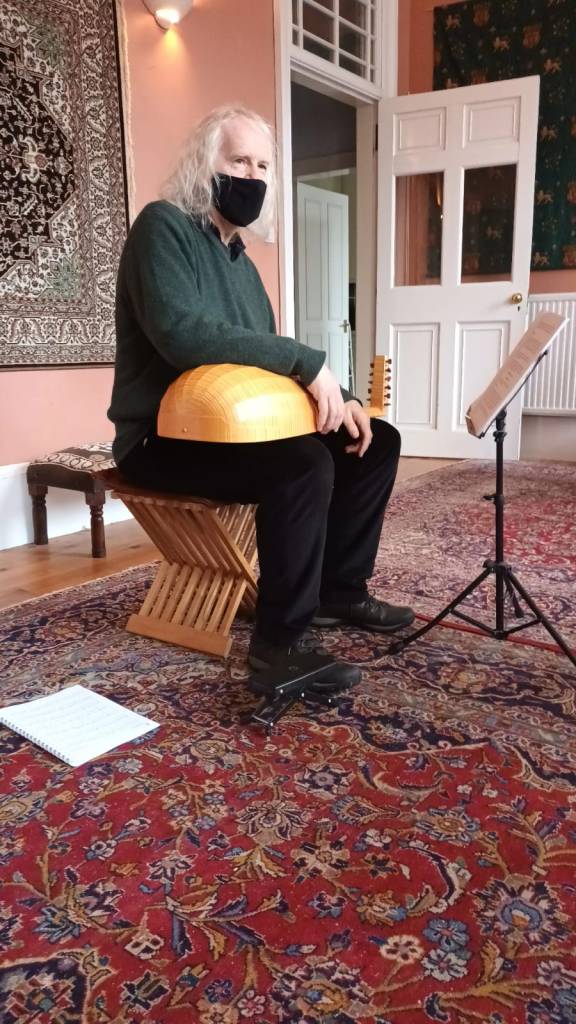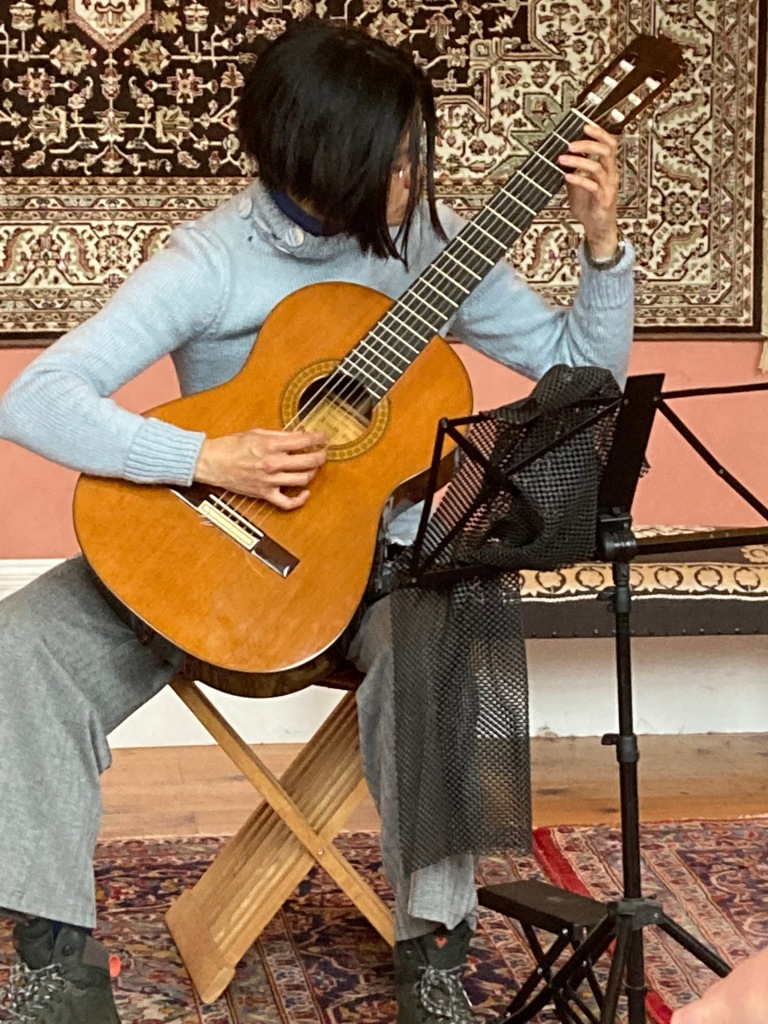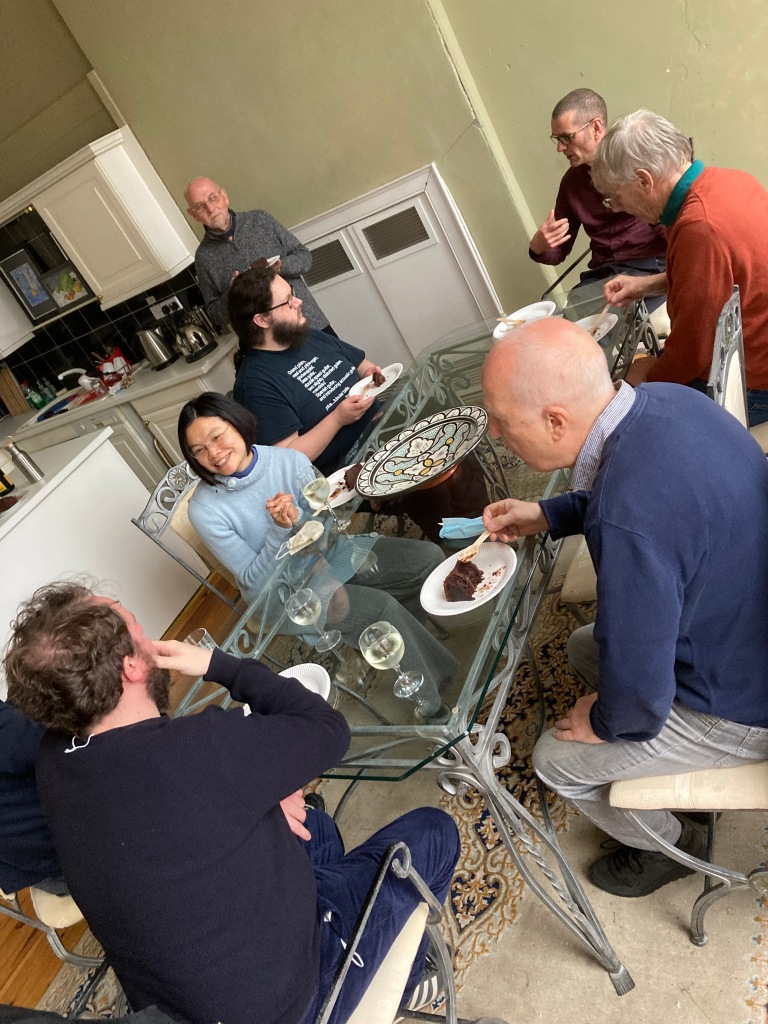Report of 35th Meeting, 9th October, 2021
This meeting marks the tenth anniversary of the first meeting of SLEGS which took place on 1st October 2011, in the Laigh Room at St Cecilia’s Hall. There was a great turnout of eleven members, including three who attended the inaugural meeting; Rob Mackillop, Gordon Ferries and Bill Samson.
Rob, Bill and Philip Lord have organised the meetings up until now, and decided that it was time for a ‘regime change’. Chris Jupp and Eric Thomas are the new management and will take over running SLEGS after today’s meeting.
Rob took his usual role as master of ceremonies today and as this was also his own 30th anniversary as a lute player, he started by recounting his life as a musician, including his time at Royal Scottish Academy of Music and Drama, studying guitar in Italy and buying his first lute – an archlute – on which he learned how to play continuo from figured bass in three weeks before performing Monteverdi operatic excerpts with the Scottish Early Music Consort.
He went on to record quite a number of CDS on lutes, citterns and historical guitars, three of which reached the Number One spot in the Scottish Classical Music Chart (The Scotsman). Highlights of his performing career include a tour of Japan, and a solo lute recital live on BBC Radio 3. He now makes his living by teaching students around the world on Zoom, and writing, editing and composing music books for the American publisher, Mel Bay, recently finishing his 20th book.
He spoke about how he contacted Bill Samson to help him set up SLEGS in 2011, with the aim of allowing amateur lute and early guitar players to perform to each other, and as a forum in which to exchange advice, information and ideas.
Rob then performed a number of pieces from his ‘Introduction to the Lute’ for beginner lute players and guitarists wishing to play lute music on the guitar (Mel Bay, 2016). This book contains pieces to be played on a 6-course lute or any other six stringed instrument tuned like a lute. In it he discusses technique, presents exercises starting with single notes, then diads and how to read from tablature (French or modern guitar tablature). The repertoire covered includes early Italian, a wealth of vihuela repertoire, Scottish lute music, John Dowland and early German and French lute music.
He was playing a 6-course lute in E by Martin Shepherd. The pieces, which covered a diverse range of genres were:
A duet for one lute, by Miguel Fuenllana
Fuenllana’s intabulation of Josquin’s two-part Fecit Potentiam
Luis de Narvaez – Fantasia del quarto tono
Spinacino’s Recercare a Juli Amours
A Toye[1] from Jane Pickeringe’s Lute Book
‘Rhona’s Tune’ – Jane Pickeringe’s Lute Book #17
‘Drawe neare me and lowe me’ – Jane Pickeringe’s Lute Book
[These last two are Scottish pieces]
Rob discussed the emergence of a solo instrumental style out of strict two-part pieces. At Bill Samson’s request he also performed a piece that doesn’t appear in Introduction to the lute, a German renaissance fantasia by Benedict de Drusina, from The Lute Society’s edition of German Renaissance Sources.
The deep sonority of the lute in E suited the music perfectly, particularly in the more introspective pieces. All the music was beautifully interpreted by Rob, but if I had to name a favourite it would be the lovely ‘Drawe neare me and lowe me’. It was a fitting farewell from Rob, who intends to now retire from performing live, though will keep posting YouTube videos on his channel: https://www.youtube.com/user/RobMacKillop
Next up was Bill Samson, playing on a self-made guitar modelled after an 1839 guitar by Rene Lacote. Fernando Sor died in 1839, so this was the kind of guitar that was used when he was alive.
The pieces played were all studies by Sor: Op 35 nos 1 and 2, Op 60 nos 5 and 6
Bill’s guitar sounded beautifully reverberant in the louder, more committed passages, and sweet in the less demonstrative sections.
Glen Robertson gave his first SLEGS performance, playing the following anonymous pieces with great aplomb and with a number of his own embellishments:
Calleno Casturame (also called Calleno Custure Me)
Blue Breiks from the Skene manuscript
Pumpernickel from the Berlin lute book.
It was a confident recital of repertoire he uses to entertain school kids at educational visits to Stirling Castle.
Stuart McLuckie played his 11c lute by Paolo Busato. He chose three anonymous pieces from Miguel Serdoura’s method for the baroque lute: Gris de Lin, Les Tricotins, and a minuet. Stuart grew in confidence during his short recital, which augurs well for future meetings. His performances on the baroque lute have come on greatly since he started playing it at SLEGS meetings. The Menuet was particularly delightful.
Glo Lo made a welcome return to SLEGS. She was playing a beautiful Sanchez guitar, strung in gut trebles. She played without fingernails the following pieces: Sor Etudes in D and Bm, Matteo Carcassi Etudes in A (Op60 No 3) and F (Op 60 No. 16), and Francisco Tarrega’s ‘Adelita’ (Mazurka).
Glo put us all to shame by playing all of the above pieces from memory. The pieces by Carcassi were particularly enjoyable.
[At this point in the proceedings we had a break for some delicious ‘tenth anniversary’ vegan chocolate and raspberry cake and Champagne!].
Chris Jupp played a 6c lute in G by Luke Emmet (Orlando Lutes): Marco d’Aquila Recercar no 4, Da Crema’s intablulation of Arcadelt’s ‘Lascia in Vello’, and Dalza’s popular Calata ala Spagnola.
These covered an instrumental piece, a song intabulation and a dance showing us three different aspects of the development of lute music in the 16th century. Chris’s performance was very well executed, as we have come to expect from him.
Eric Thomas was the final performer of the afternoon. Eric introduced himself, saying that he is working on a PhD with the Huddersfield University investigating the development of the lute, its technique and its repertoire during the 16th century and explaining ricercares and fantasias are distinct musical forms. He played a Bossinensis Ricercare (in an improvisatory style), a Spinacino Ricercare (in a more carefully planned style), two different ricercars by Francesco da Milano, interspersed with a Fantasia by Marco d’Aquila. It is clear that Eric will be a performer of note once his doctorate has been accepted. We (sort of) look forward to the days when we can’t afford to pay him to play to us!
The meeting ended at 4pm, when Rob and Bill handed on the management of SLEGS to Chris and Eric. Expect exciting plans and a new website in due course.











Leave a Reply